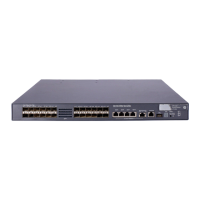110
RMON groups
Among the RMON groups defined by RMON specifications (RFC 2819), the device has realized the
statistics group, history group, event group, and alarm group supported by the public MIB. Besides, HP
also defines and implements the private alarm group, which enhances the functions of the alarm group.
This section describes the five kinds of groups in general.
Ethernet statistics group
The statistics group collects statistics of various traffic information on an Ethernet interface and saves the
statistics in the Ethernet statistics table (ethernetStatsTable) for query convenience of the management
device. It provides statistics about network collisions, CRC alignment errors, undersize/oversize packets,
broadcasts, multicasts, bytes received, packets received, and so on.
After the creation of a statistics entry on an interface, the statistics group starts to collect traffic statistics on
the interface. The result of the statistics is a cumulative sum.
History group
The history group periodically collects statistics of traffic information on an interface and saves the
statistics in the history record table (ethernetHistoryTable) for query convenience of the management
device. The statistics include bandwidth utilization, number of error packets, and total number of packets.
A history group collects statistics on packets received on the interface during each period, which can be
configured at the CLI.
Event group
The event group defines event indexes and controls the generation and notifications of the events
triggered by the alarms defined in the alarm group and the private alarm group. The events can be
handled in one of the following methods:
• Log—Logging event related information (the occurred events, contents of the event, and so on) in the
event log table of the RMON MIB of the device, and the management device can check the logs
through the SNMP Get operation.
• Trap—Sending a trap to notify the occurrence of this event to the network management station
(NMS).
• Log-Trap—Logging event information in the event log table and sending a trap to the NMS.
• None—No action.
Alarm group
The RMON alarm group monitors specified alarm variables, such as total number of received packets —
etherStatsPkts—on an interface. After you define an alarm entry, the system gets the value of the
monitored alarm variable at the specified interval, when the value of the monitored variable is greater
than or equal to the rising threshold, a rising event is triggered; when the value of the monitored variable
is smaller than or equal to the falling threshold, a falling event is triggered. The event is then handled as
defined in the event group.
If the value of a sampled alarm variable overpasses the same threshold multiple times, only the first one
can cause an alarm event, which means the rising alarm and falling alarm are alternate. As shown in
Figure 41, the v
alue of an alarm variable (the black curve in the figure) overpasses the threshold value
(the blue line in the figure) for multiple times, and multiple crossing points are generated, but only
crossing points marked with the red crosses can trigger alarm events.

